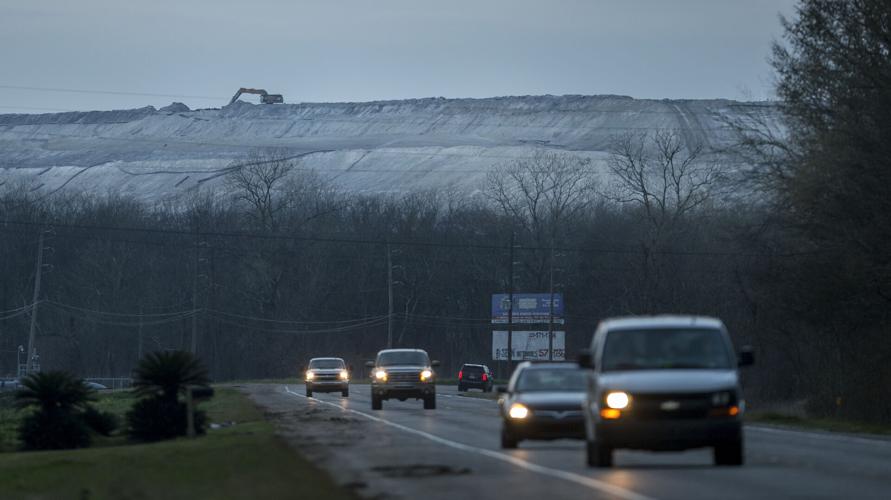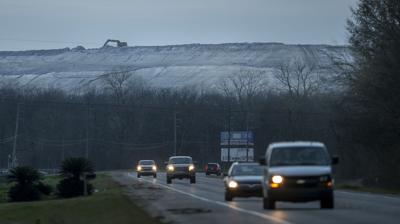A fertilizer plant's towering mound of slightly radioactive waste along the Mississippi River in St. James Parish is being allowed to expand by state regulators, a move the company says is necessary to make up for ground lost to stability issues that had earlier posed concerns.
Mosaic Fertilizer's mound at the Uncle Sam plant in Convent, so tall it has its own aviation warning lights, is familiar to residents and those who drive through the area. It contains chalk-colored phosphogypsum, with acidic lakes embedded in the pile.
Environmental and neighborhood groups are concerned about the expansion, while the company says it is unavoidable and will allow it to continue to operate as it already has for years. Along with its Faustina plant across the Mississippi, Mosaic employs 344 people and 200 contractors, is a top taxpayer in the parish and provides a critical resource for row crops that feed people worldwide, the company says.
"The solid waste permit renewal allows us to continue our operation of the gypstack at Uncle Sam," said Ashleigh Gallant, a spokeswoman for Mosaic. "We are seeking no change either to the volume or materials we will inject."

Ron Yasurek, Mosaic general manager of phosphate operations, stands Tuesday, Jan. 29, 2019, on a roadway atop a 200-foot-high pile of white waste called phosphogypsum. A byproduct of fertilizer production, the gypsum pile supports and encases giant cooling ponds for highly acidic process water at the company's complex next to the Mississippi River in Convent. The 140-acre lake, at left, is one of those cooling ponds and sits at the top of the waste stack 200 feet in the air. One of the gypsum walls supporting this lake has been shifting unexpectedly and company officials and regulators have begun draining the pond to try to halt the movement. Â
In a recent decision, the state Department of Environmental Quality allowed the pile, also known as a "gypstack," to expand, but that's not the only issue concerning residents. Environmental groups are petitioning the agency for a public hearing on Mosaic's proposed renewal of permits to continue injecting hazardous, contaminated process water underground.
With two wells in place for more than a decade, Mosaic has used underground injection to help maintain safe water levels in the stack's 300 acres of lakes. Water in the storage lakes is acidic, laced with heavy metals and radioactive elements from the phosphate rock, along with contaminated rainfall runoff from exposed parts of the pile.Â
"Weâve seen the long-term consequences of such decisions before, and itâs clear that without strict oversight and a commitment to transparency, we are putting our neighborhoods at risk," said Shamell Lavigne, chief operating office of community group Rise St. James. "Itâs time for regulators and policymakers to put public safety first and rigorously reexamine these permits to ensure that our community is not being exposed to undue hazards."
Mosaic's stack, accumulating since the 1970s, is currently one of the tallest points for miles in the rural zone of cane fields, riverside hamlets and chemical, coal and iron facilities. With grassy slopes and chalky white splotches of phosphogypsum, it can be seen from the Sunshine Bridge.Â
With the new expansion, the pile is projected to ultimately encompass up to 1,300 acres and hold hundreds of millions of cubic yards of waste permanently, permit papers say.
Similar issues in Florida
The expansion's origin was six years ago, when the pile began shifting, raising fears about its stability. State and federal regulators and Mosaic consultants blamed the problem on a weak zone in soils about 75 to 100 feet underground. Testing from the 1970s had hinted at the issue, but the plant's then owners dismissed it as a few bad samples, DEQ papers say.
Over the following years, Mosaic and regulators took steps to monitor and eventually halt the pile's movement by shifting the waste material away from the weak zone and by largely draining a nearly 200-foot-tall, 140-acre lake, permit papers say.
Mosaic also came up with the plan to expand dumping on adjacent ground to make up for lost capacity, the papers say. DEQ officials authorized this proposed 330-acre expansion with a permit last month, nearly a year after they and the EPA determined that the pile movement had effectively stopped and the years of "crisis conditions" had ended.
The expansion will allow dumping for at least another 18 years, permit records say, but will be on land with signs of similar underground concerns as the area that moved several years ago. The company is vouching for its safety.
Mosaic canât operate without dumping phosphogypsum, a byproduct from the phosphate rock and its naturally occurring metals and radioactive elements. Mosaic makes agricultural fertilizer from the rock, but the process creates more than 5 pounds of waste phosphogypsum for every pound of saleable product, permit papers say.

The waste phosphogypsum is pumped to active areas of stack from a production plant and deposited in a wet slurry.Â
Decades ago, the EPA settled on open-air stacking of phosphogypsum as the best and essentially only solution for handling the waste. It is regulated under a special hazardous waste exemption.
Though the source rock can contain radioactive uranium, thorium and radium-226, it is the radium in the phosphogypsum and its ability to degrade into radon-222 that the EPA rules are designed to limit. The colorless and odorless radioactive gas can cause lung cancer, the EPA says.
Dumped phosphogypsum can't exceed certain radioactivity levels set by the agency and gypstacks also fall under maximum radioactivity limits deemed to have an acceptable health risk. Mosaic says it mitigates radioactivity further with several feet of eventual earthen cover over the gypsum.
Environmental groups and residents argue safety and health concerns remain. The industry has had similar stability problems in Florida that led to major releases of contaminated acidic waters into Tampa Bay and surrounding wetlands, they say.
A catastrophic release of the pileâs contaminated process water could end up in nearby swamps and the Blind River, Rise St. James contends. They also argue the company downplayed the expansionâs air pollution impact on minority communities. Citing EPA data, other groups say Mosaic already has a poor track record of regulatory compliance.
âDue to lack of clarity regarding the massive expansion within this ârenewal,â chronic noncompliance with existing solid waste permits, noncompliance with other environmental permits, multiple recent enforcement actions, and significant environmental justice concerns, LDEQ cannot grant this permit and fulfill its constitutional duties,â Matt Rota, senior policy director for Healthy Gulf, wrote in comments last year.
DEQ officials did not respond to a request for comment but, in permit papers, said particulate and toxic pollution around the Mosaic pile are well below federal air standards and won't cause adverse health conditions for nearby residents.
âSignificantly reduceâ the risk
Mosaic says the expansion, which could reach 160 feet, would serve as a buttress for the section of the pile with the past instability. DEQ officials agreed.
"This additional support will significantly reduce the risk of slope failure, thereby improving the overall structural integrity and safety of the stack system," state regulators said in their document laying out the reasons for the permit's approval.
But, underneath where the new expansion known as "Stack 5" is to be built along La. 3214, Mosaic's ground testing found additional underground weaknesses of a similar kind and depth to the one blamed for the 2019 scare, state regulatory papers show.
The weak area is about 85 feet deep and near a layer of marine clay deposits of the kind pinpointed elsewhere.
"It appears that the subject, soft organic layer is likely to be encountered to the mid- and eastern-side of the proposed Stack 5 area, and it appears to be more prevalent in the mid and southeastern sides of the area," according to a May 2022 internal company letter from Mosaic's engineers, Ardaman & Associates Inc.
Mosaic's engineers have produced modeling showing the pile's stability would be above the minimum level DEQ requires even with the weak zone identified.
Cane farmers working alongside the gypstack in late 2018 and early 2019 discovered the previous instability, when they encountered fields heaved upward by the pileâs moving leading edge.
Afterward, Mosaic outfitted the mound with monitors and, for the expansion, has plans to add more for advance warning of any early signs of movement, permit papers say. Mosaic has also promised to take early steps to see how those weak zones respond to dumping and will potentially slow or otherwise alter the new wing's construction based on that response.
A principle in this kind of geotechnical engineering is that the slow piling of the waste actually helps weak soils compress, squeeze groundwater outward and upward, and add strength over time as the soils consolidate under the pressure of all that weight.
To help with stability and protect groundwater, Mosaic is also promising to install underground drainage systems, natural clay liners at the base and synthetic liners inside the future pile, permit papers say.
The new dumping zone would require a year of monthly reporting, followed by annual reporting, the papers say.
Left unanswered is whether Mosaic would still seek its previously anticipated final phase of the pile that would bring its overall height to 310 feet, which is about two-thirds of the height of the State Capitol in Baton Rouge. Mosaic's engineers say they are still evaluating that plan's viability.




